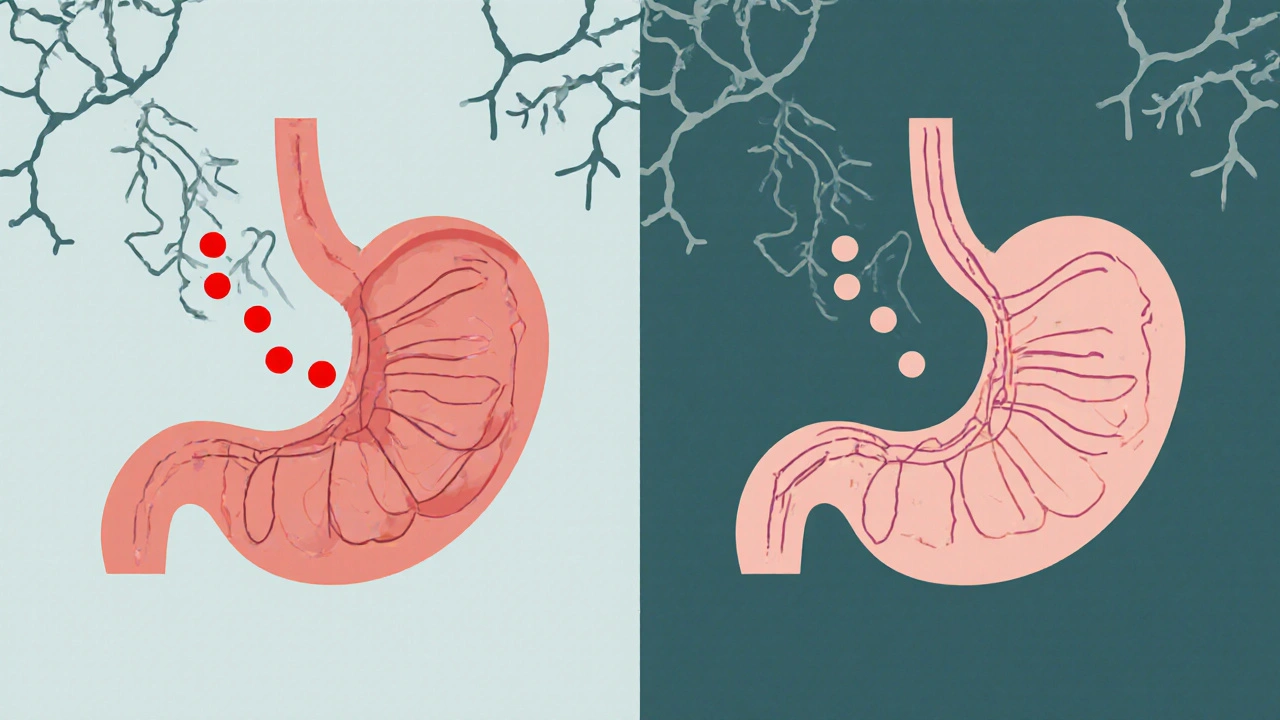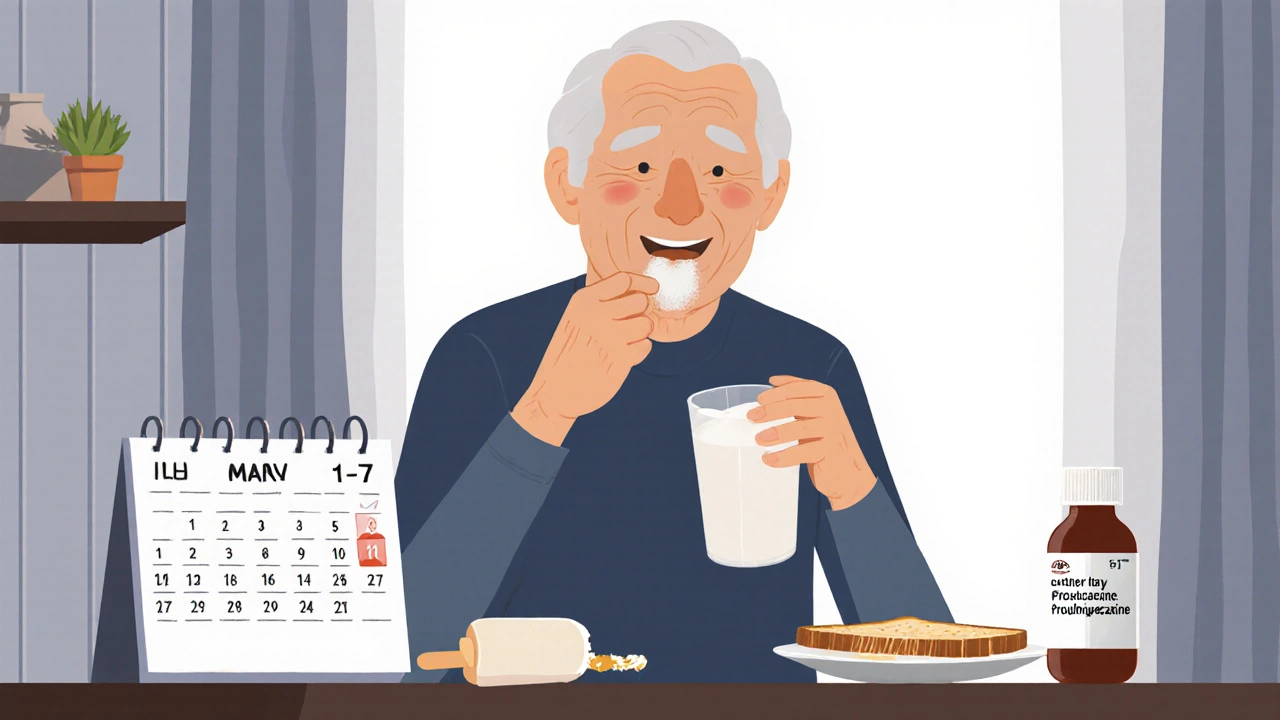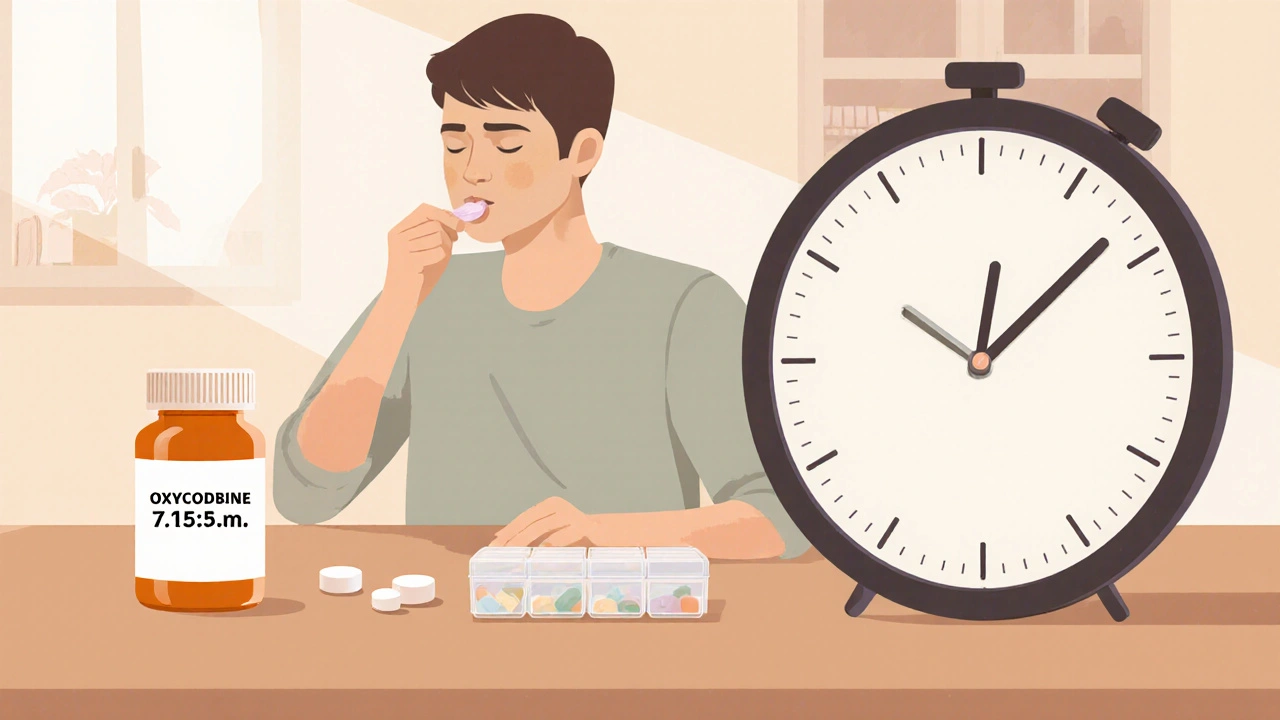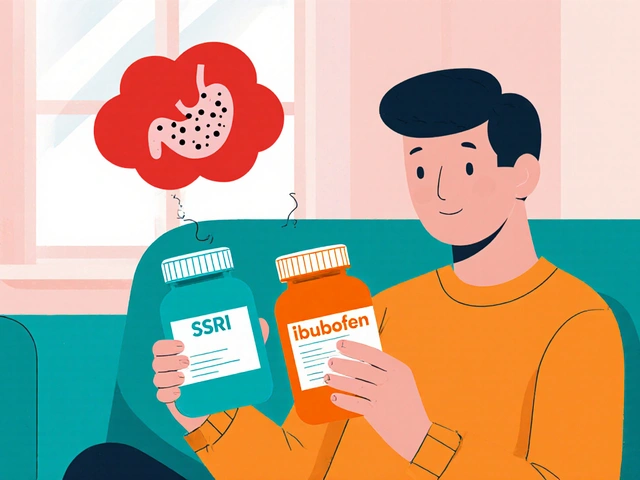Opioid Nausea Management Tool
Calculate Your Optimal Antiemetic Timing
Opioid Conversion Calculator
Recommended Antiemetic Timing
Dietary Recommendations
Take small, frequent meals. Avoid high-fat foods and strong smells. Stay hydrated with small sips of water or ginger tea.
Opioid Conversion Result
Conversion ratios are approximate. Always consult your healthcare provider for personalized dosing.
When you start taking opioids for pain, nausea isn’t just a side effect-it’s often the reason people stop taking them. About 30 to 40% of people new to opioids feel sick to their stomach within the first few days. It’s not weakness. It’s not bad luck. It’s biology. Opioids bind to receptors in your brainstem, specifically in the chemoreceptor trigger zone, and that’s what flips the nausea switch. For many, it fades after a week. But for others, it lingers and makes pain management impossible.
Why Opioid Nausea Happens (And Why It Doesn’t Always Go Away)
Opioids like morphine, oxycodone, and hydrocodone don’t just block pain signals. They also mess with your brain’s vomiting center. That’s why nausea hits so fast-often within hours of your first dose. Most people build tolerance to it within 3 to 7 days. But if your dose keeps climbing, or if you’re older, or if you’re on multiple medications, that tolerance might not come fast enough-or at all.
Here’s the catch: nausea doesn’t always mean you’re taking too much. Sometimes, it’s about how your body handles the drug. People over 65 are more sensitive. Those with slow digestion or existing gut issues are more likely to feel sick. And if you’re on other meds that affect liver enzymes (like some antibiotics or antifungals), your opioid levels can spike, making nausea worse.
Antiemetics: What Actually Works
Not all anti-nausea drugs are created equal. The ones that work best for opioid-induced nausea target the brain’s dopamine system, not just the stomach.
- Haloperidol (0.5-2 mg daily): A low-dose antipsychotic that blocks dopamine in the brainstem. It’s cheap-under 5 cents a pill-and works for 70-75% of patients. But it can cause stiffness or tremors in older adults.
- Prochlorperazine (5-10 mg every 6-8 hours): A phenothiazine that’s gentler than haloperidol. Often the first pick for cancer patients. Works well if nausea is tied to the brain, not the gut.
- Metoclopramide (5-10 mg every 6-8 hours): This one speeds up your stomach. Good if you’re bloated, constipated, or feel nauseous after eating. But it can cause muscle spasms in 10-15% of users, especially at higher doses.
- Ondansetron (4-8 mg every 8 hours): Blocks serotonin. Works okay for sudden nausea but often fails for ongoing opioid-induced vomiting. Costs 70 times more than haloperidol.
Here’s what doesn’t work well: taking antiemetics before you even start opioids. Studies show prophylactic use doesn’t prevent nausea. It only helps once symptoms show up. And don’t rely on ginger or peppermint tea alone-they might soothe mild nausea, but they won’t stop opioid-induced vomiting.
Timing Matters: When to Take the Anti-Nausea Pill
Most people take their antiemetic at the same time as their opioid. That’s wrong.
Opioids peak in your blood about 60 to 90 minutes after you swallow them. If you take your antiemetic at the same time, it won’t be at full strength when the opioid hits. You need to beat it to the punch.
Take your antiemetic 30 to 60 minutes before your opioid dose. That way, it’s already working when the opioid arrives. For example: if you take oxycodone at 8 a.m., take prochlorperazine at 7:15 a.m. This simple shift can cut nausea in half.
For IV opioids (like in hospitals), give the antiemetic 15-20 minutes before the infusion starts. Same logic-timing is everything.

Diet Adjustments: What to Eat (and What to Avoid)
Diet doesn’t fix opioid nausea, but it can make it bearable-or worse.
- Small, frequent meals help. A big plate of food slows digestion, which makes nausea worse. Eat 4-5 tiny meals instead of 3 big ones.
- Low-fat, low-spice foods are easier to keep down. Avoid fried food, creamy sauces, and heavy spices. Stick to toast, rice, bananas, broth, and plain yogurt.
- Stay upright after eating. Don’t lie down for at least 45 minutes after a meal. Gravity helps keep stomach contents where they belong.
- Hydration matters. Sip water, ginger tea, or electrolyte drinks slowly. Don’t chug. Dehydration makes nausea feel worse.
- Avoid sugar-heavy drinks. Soda and juice can trigger bloating and worsen nausea, especially if you’re also constipated (which most opioid users are).
Some people find that eating dry crackers before getting out of bed helps with morning nausea. Others swear by cold foods-like applesauce or popsicles-because they’re less aromatic. Smell is a big trigger. If your food smells strong, nausea follows.
Opioid Rotation: Switching to Reduce Nausea
If nausea sticks around after a week, even with antiemetics, it might be time to switch opioids.
Not all opioids cause the same level of nausea. Morphine? High risk. Oxycodone? Still common. But some people find relief switching to:
- Hydromorphone: Studies show 40-50% of patients feel less nauseous after switching from morphine.
- Methadone: Less likely to trigger nausea, but switching requires careful dosing. Only do this under specialist care.
- Tramadol: Sometimes better tolerated, but not for everyone-it can still cause nausea and has seizure risks at high doses.
Don’t switch on your own. Dosing isn’t one-to-one. Going from 30 mg of morphine to hydromorphone isn’t just swapping pills. It’s a math problem. A 3:1 ratio is often used (30 mg morphine ≈ 10 mg hydromorphone), but your doctor needs to calculate it based on your pain level, kidney function, and age.
When to Lower the Opioid Dose (Yes, Really)
You might think: if nausea is bad, I need more pain control. But sometimes, the opposite is true.
Research shows that if you’re getting good pain relief but still feeling nauseous, lowering your opioid dose by 25-33% can eliminate nausea in about 60% of cases-without losing pain control. Why? Because nausea is dose-dependent, but pain relief isn’t always. Your body might need less than you think.
Try this: if you’re on 10 mg of oxycodone every 6 hours and feel nauseous, ask your doctor about dropping to 7.5 mg. Give it 2-3 days. If pain is still manageable, keep it. You might be surprised how little you actually need.

What Doesn’t Work (And Why People Keep Trying It)
There’s a lot of misinformation out there.
- “Just wait it out.” Maybe. But if you’re vomiting daily for two weeks, you’re not building tolerance-you’re getting weaker.
- “Take it with food.” That helps with stomach upset from aspirin or ibuprofen, not opioid-induced nausea. Opioids affect your brain, not your gut lining.
- “Use ondansetron first.” It’s expensive and often ineffective for opioid nausea. Save it for chemo or post-op vomiting.
- “Try cannabis.” Some patients report relief, but evidence is anecdotal. Plus, it’s not legal everywhere and can interact with opioids.
The truth? Most people give up on opioids because they’re not told what to do about nausea. They’re handed a script and told, “It’ll pass.” But if you’re not given tools to manage it, it won’t.
What to Do If Nothing Works
If you’ve tried:
- Timing your antiemetic correctly
- Switching antiemetics (haloperidol, prochlorperazine, metoclopramide)
- Adjusting your diet
- Lowering your opioid dose
- Switching opioids
…and you’re still vomiting daily, you need a specialist. Palliative care teams have more experience with this than most primary doctors. Ask for a referral. There are new drugs in trials-like 6β-naltrexol-that block opioid nausea without reducing pain relief. They’re not on the market yet, but experts are watching closely.
And if you’re one of the 42% of cancer patients who stopped opioids because of nausea? You’re not alone. But you don’t have to stay that way.
How long does opioid-induced nausea last?
For most people, nausea from opioids lasts 3 to 7 days after starting or increasing the dose. Tolerance usually develops by then. But if you’re older, on high doses, or taking other medications, it can last longer-sometimes weeks. If it hasn’t improved after 10 days, talk to your doctor about changing your treatment plan.
Can I take anti-nausea meds with my opioid at the same time?
It’s better not to. Opioids reach peak levels in your blood 60-90 minutes after you take them. If you take your antiemetic at the same time, it won’t be at full strength when the opioid hits. Take the anti-nausea pill 30-60 minutes before your opioid for the best results.
Is metoclopramide safe for older adults?
Use caution. Metoclopramide can cause muscle spasms, restlessness, or tremors in people over 65, especially at doses higher than 10 mg per day. Haloperidol or prochlorperazine are often safer choices for older patients, though they carry their own risks. Always start low and monitor closely.
Can I stop my opioid if the nausea doesn’t go away?
Don’t stop suddenly. That can cause withdrawal symptoms like sweating, anxiety, and increased pain. Instead, talk to your doctor. You may need to lower your dose, switch opioids, or try a different antiemetic. Stopping without a plan can make your pain worse and your nausea harder to control.
Do I need to take antiemetics forever?
No. Most people only need antiemetics for the first 1-2 weeks of opioid therapy. Once your body adjusts, you can usually stop them. If nausea returns after stopping, it could mean your dose was increased too quickly-or you’re on a different opioid. Revisit your plan with your doctor.
Final Thought: You Don’t Have to Suffer to Be Pain-Free
Opioids save lives. But they shouldn’t make you feel like you’re going to throw up every time you take them. Nausea isn’t a normal part of pain treatment-it’s a solvable problem. With the right timing, the right drug, and the right diet, most people can manage it. You don’t have to choose between pain relief and feeling sick. There’s a better way.







I wish someone had told me this when I started oxycodone after my surgery. Took me three weeks to figure out timing was everything. Taking the prochlorperazine 45 minutes before my dose cut my nausea by 80%. No more vomiting at 3am. Just wish the docs would actually teach this instead of handing out scripts and hoping for the best
The pharmacokinetic rationale for pre-timing antiemetics is well established in the literature. Opioid Cmax occurs between 60 and 90 minutes post oral administration. Administering dopamine antagonists prior to peak plasma concentration ensures adequate receptor occupancy at the CTZ. Failure to adhere to this temporal protocol results in suboptimal therapeutic efficacy
This is one of those posts that should be printed and handed out with every first opioid prescription. I work in palliative care and see too many patients quit pain meds because they weren’t told about the timing trick. Haloperidol is a game changer for older adults if you start low and go slow. Also agree about diet-cold foods are lifesavers. Smell is the silent killer here
honestly i didnt believe the 30 min before thing until i tried it. my doc just said take them together so i did. turned out i was throwing up every time i took my pain meds. switched to taking the haloperidol 45 min early and suddenly i could eat breakfast without feeling like i was gonna die. also low fat = no regret. thanks for this
They don't want you to know this because big pharma makes more money selling ondansetron and keeping you dependent on high doses. The real solution is to avoid opioids entirely. Nausea is your body screaming that it doesn't want this poison. The system is rigged
Americans are so weak. In my country people take morphine for weeks without a single antiemetic. You just learn to deal with it. This whole 'timing' and 'diet adjustment' nonsense is why our healthcare costs are insane. Just take the pill and stop whining
I’m so glad someone finally put this all together!! I’ve been begging my doctor to try haloperidol for months-he kept pushing ondansetron (which cost me $120 a month!!). When I switched to 1mg haloperidol at 7:15am before my 8am oxycodone? Magic. I cried. I actually ate a whole bowl of oatmeal without wanting to hurl. And yes-cold applesauce is my new best friend. Thank you for validating what I’ve been fighting for
So let me get this straight… you’re telling me the solution to nausea is… not vomiting? Groundbreaking. Next you’ll tell me water is wet and fire is hot. My grandma took morphine for 10 years and never once took a ‘anti-nausea pill’-she just sat there looking miserable. That’s just life, honey
Metoclopramide is dangerous for seniors. Just say no. Haloperidol’s fine if you’re young. But if you’re over 65? Stick with prochlorperazine. And no, ginger tea won’t help. Stop listening to TikTok.